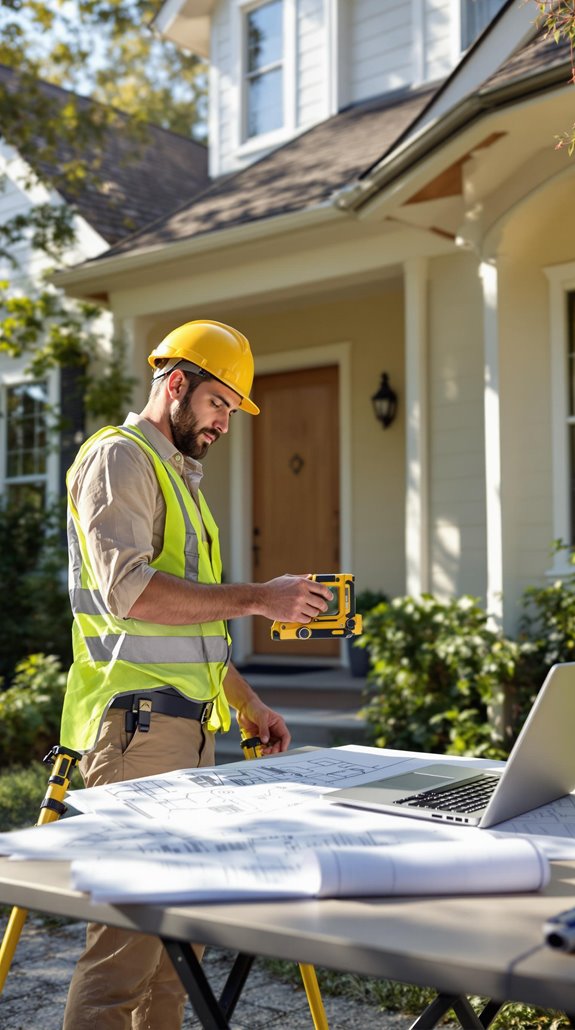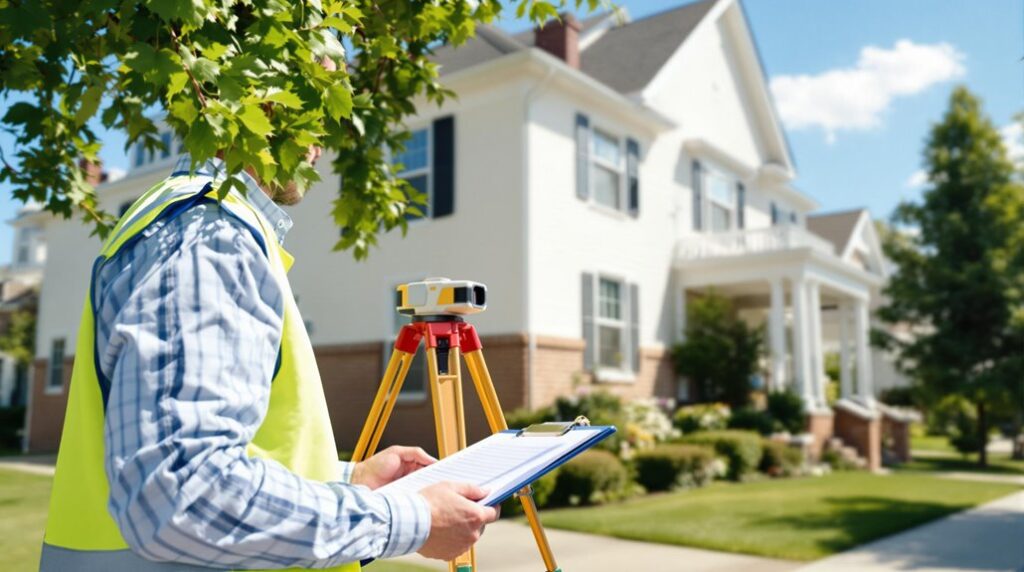I’ve spent years analyzing structural survey costs, and I can tell you that most homebuyers overpay simply because they don’t understand the pricing structure. The difference between a £300 basic inspection and a £2,500 thorough survey isn’t always what you’d expect, and knowing which type you actually need can save you hundreds while still protecting your investment. Let me break down the real costs and show you exactly where your money goes.
Key Takeaways
- Structural survey costs range from £250-£5,000 depending on property value, with standard homes costing £400-£1,500.
- Choose appropriate survey level: Condition Reports for newer properties, HomeBuyer Reports for standard homes, Building Surveys for older properties.
- Reduce costs by obtaining multiple quotes, hiring local RICS-certified surveyors, and clarifying scope upfront to avoid additional fees.
- Surveys provide negotiation leverage, with 30% of buyers securing lower purchase prices and avoiding unforeseen expenses averaging £5,000+.
- Negotiate fixed-fee agreements with phased payments and verify surveyor’s RICS accreditation to ensure professional standards and cost certainty.
Structural Survey Cost Breakdown by Property Value
Five distinct price tiers determine structural survey costs, with property value serving as the primary factor in pricing decisions. I’ll break down what you can expect to pay across different property values.
For properties under £100,000, you’re looking at £250-£350 for a basic Condition Report. This covers surface-level defects but won’t dig deep into structural concerns.
Properties valued £100,000-£250,000 typically require HomeBuyer Reports costing £400-£700. You’ll get visual inspections for structural issues and damp problems.
Higher-value properties £250,000-£500,000 need Building Surveys ranging £600-£1,000, while luxury homes £500,000-£1,000,000 require Full Structural Surveys costing £900-£1,500+.
Premium properties exceeding £1,000,000 demand thorough surveys that’ll cost £1,500-£5,000, but they’re worth every penny for protecting your investment. These costs may increase further when you factor in additional services like drone imaging for hard-to-reach areas or specialist reports.
Key Factors That Impact Your Survey Pricing
While property value sets the baseline for structural survey costs, several critical factors can considerably increase or decrease your final bill. I’ve found that property characteristics play the biggest role—larger, older homes with complex layouts demand more inspection time and expertise. Additionally, early detection of subsidence can significantly reduce the overall costs of repairs and assessments. Your surveyor’s qualifications matter too; RICS-certified professionals with specialized experience in historic properties or structural issues typically charge premium rates.
The survey scope you choose dramatically affects pricing. Basic structural surveys cost less than thorough building surveys that include detailed defect analysis. Technology also impacts costs—traditional measurement methods keep fees lower, while 3D laser scanning and advanced software increase expenses but provide superior accuracy.
Finally, location influences pricing through travel costs, regional wage variations, and local market demand for surveying services. Urban areas typically command higher fees due to increased demand and operating costs compared to rural locations.
Labour Costs and Service Fee Components
Understanding these pricing factors helps you anticipate costs, but the actual expense breakdown reveals where your money goes during a structural survey.
I’ll break down the main labour components you’re paying for. Technical expertise commands premium rates—surveyors with specialized equipment like 3D laser scanners require extensive training. You’re covering their time for setup, calibration, and data collection, plus the significant post-survey processing that consumes 30-40% of total project hours.
Service fees include point cloud registration, model creation, and quality assurance checks. If you need detailed deliverables like 3D Revit models or cross-section drawings, expect higher costs due to specialized software requirements and extended revision cycles.
Travel time, equipment transport, and safety protocols for restricted access sites add operational expenses that directly impact your final invoice. Building surveyors assess comprehensive property conditions including electrical systems and plumbing, which requires broader expertise and more time than structural-only inspections.
What’s Not Included in Standard Survey Packages
Most property buyers assume their structural survey covers everything they need, but standard packages typically exclude several critical components that could affect your decision and budget.
I’ve found that basic surveys won’t include detailed room-by-room condition analysis or thorough photographic documentation. You’re also missing advanced technical measurements like 3D laser scanning, drone surveys, and point cloud data generation that provide precise structural details. Understanding building regulations can help you plan for necessary assessments and avoid unexpected costs.
Standard packages exclude repair cost breakdowns, legal matter assessments, and Energy Performance Certificates. There’s no long-term structural monitoring or statistical analysis of movement patterns over time. Additionally, surveyors cannot open the fabric of the building without your explicit consent, which means hidden structural issues may remain undetected.
Most importantly, you won’t get custom survey design tailored to your specific property type or detailed floor plans and elevations. These exclusions can leave you vulnerable to unexpected costs and structural issues after purchase.
Smart Strategies to Reduce Survey Expenses

Standard survey packages leave gaps that can cost you thousands, but strategic planning can greatly reduce your structural survey expenses without compromising quality.
I’ve found that selecting the right survey level prevents overpayment—Condition Reports work for newer properties, while HomeBuyer Reports suit standard homes. Full Building Surveys are only necessary for older or unique properties, especially when considering home extension costs that may arise from structural issues.
Getting three quotes reveals significant price variations. I always compare detailed breakdowns to understand what’s included and negotiate based on competitor rates.
Local surveyors reduce travel costs and work more efficiently due to area familiarity. They’re also motivated to maintain community reputation.
Finally, I minimize additional costs by clarifying scope upfront, ensuring full property access during initial inspections, and consolidating all requests to avoid multiple trip fees. The investment in a quality survey pays dividends since approximately 30% of buyers successfully leverage survey findings to negotiate significantly lower purchase prices.
When Level 3 Surveys Are Worth the Investment
While Level 1 and Level 2 surveys handle most property purchases, Level 3 Building Surveys become essential investments when you’re dealing with properties that carry significant structural or financial risks.
I’d recommend Level 3 surveys for properties over 50 years old, especially those with non-traditional construction like timber frames or thatched roofs. If you’re buying above £500,000, the survey fee of £500-£2,000 protects against repair costs that could hit £20,000-£50,000. Conducting a Level 3 survey can also unveil hidden defects that may not be immediately apparent during initial viewings.
You’ll get real negotiating power—87% of buyers renegotiate after Level 3 findings, typically securing 5-15% price reductions. The survey reveals hidden defects through invasive checks, assesses compliance of renovations, and creates detailed maintenance schedules. Property size and complexity directly impact both the survey duration and the overall cost you’ll pay. For heritage properties or homes showing structural damage, it’s your financial safety net.
How to Choose the Right RICS-Accredited Surveyor

Finding the right RICS-accredited surveyor can save you thousands in missed defects and poor advice. I’ll help you identify the professionals who’ll protect your investment.
First, verify their RICS status. Look for Chartered (MRICS) rather than Associate (AssocRICS) – it’s the gold standard for practicing surveyors. Chartered professionals earn 21% higher salaries because they deliver superior expertise.
Check their experience carefully. Direct RICS membership requires 10 years of advanced experience, while non-RICS degree holders need a minimum of 5 years. This experience directly impacts their ability to spot costly structural issues, including hidden defects that may not be visible during a casual inspection.
Evaluate their communication style. The best surveyors use Plain English, avoid jargon, and provide clear defect descriptions. They’ll offer direct contact channels for your questions, reducing uncertainty during this stressful process. Remember that RICS surveyors must adhere to strict qualifications that ensure they maintain the highest professional standards throughout their careers.
Bundling Additional Inspections for Maximum Value
Beyond securing your structural survey, bundling additional inspections can slash your total costs by 15-30% compared to booking services separately. I recommend combining structural surveys with damp assessments for pre-1950s properties, as moisture issues often cause hidden structural damage. You’ll find electrical safety checks particularly valuable when bundled with structural reviews, especially for older homes with potential wiring hazards. Proper insulation can also play a crucial role in maintaining overall property integrity and reducing energy bills through thermal efficiency improvements. Digital packages including thermal imaging and drainage assessments typically cost £900-£2,200 but deliver extensive data without incremental fees. If you’re buying a larger property, you’ll see higher absolute savings due to scaled pricing models. Book during off-peak months (November-February) for additional 10-15% discounts. RICS-accredited providers offer the best bundled rates, and you can compare options through platforms like Checkatrade. Advanced spatial mapping technology creates precise 3D models that enhance the accuracy of bundled inspection reports.
Financial Benefits That Justify Survey Costs

Although structural surveys require upfront investment, they consistently deliver financial returns that exceed their costs through multiple value-creation mechanisms. I’ve seen buyers save thousands through negotiation leverage alone – documented defects provide concrete evidence for purchase price reductions or seller-funded repairs. You’ll avoid unforeseen post-purchase expenses averaging £5,000+ by uncovering hidden structural issues invisible during casual viewings. Additionally, understanding the typical timeline for selling a house can help you strategically plan your purchase and sale.
The survey creates legal protection, reducing litigation risks by 73% through timestamped condition documentation. You’ll also access insurance savings of 15-20% through specialized policies requiring certified surveys. Most importantly, you’ll receive precise repair cost quantification and 5-year maintenance forecasts, enabling accurate budgeting for critical systems like heating and plumbing. Professional surveyors conduct this detailed inspection to assess your property’s true condition comprehensively. These combined benefits typically exceed survey costs by 300-500%.
Negotiating Fixed-Fee Agreements With Surveyors
Fixed-fee agreements with surveyors eliminate cost uncertainty and provide predictable budgeting for your structural survey investment. I’ll help you negotiate contracts that protect your interests while securing quality service.
Start by benchmarking fees against regional averages—typically $500–$1,500 for standard homes. Request phased payments: 20% upfront, 50% post-inspection, 30% upon final report delivery. This structure protects you from paying for incomplete work.
Define scope explicitly in Exhibit A, specifying exact deliverables like structural integrity reports and drainage assessments. Exclude non-core services unless formally amended. Negotiate carve-outs for unforeseen issues requiring specialist input, and cap re-inspection fees at 15% of your original quote.
Demand lien waivers upon full payment and require errors-and-omissions insurance coverage for negligent assessments. These fixed-fee arrangements provide budget certainty that aids your financial planning throughout the survey process.
Conclusion
I’ve shown you how structural surveys range from £250-£5,000 based on property complexity and value. You’ll save money by choosing the right survey type, getting multiple RICS quotes, and negotiating fixed fees. Don’t skip this investment—it’s your best defense against costly surprises and gives you serious negotiating power. The upfront cost pales compared to discovering major structural issues after purchase. Make an informed decision that protects your investment.
References
- https://www.homehow.co.uk/costs/full-structural-survey
- https://www.ucg.ac.me/skladiste/blog_609332/objava_105202/fajlovi/Creswell.pdf
- https://www.samconveyancing.co.uk/news/house-survey/full-structural-survey-cost
- https://www.sweetstudy.com/files/mgt1005researchprojectdescription-docx-9430407
- https://www.comparemymove.com/guides/surveying/structural-survey-cost
- https://structuralengineercalcs.com/cost-of-structural-survey/
- https://www.huduser.gov/portal/periodicals/cityscpe/vol23num1/Cityscape-March-2021.pdf
- https://www.angi.com/articles/how-much-does-land-survey-cost.htm
- https://brightchecker.com/how-much-does-a-home-buyers-survey-cost/
- https://www.midlandcountiessurveyors.co.uk/post/how-much-is-a-structural-survey-costs-and-factors-explained

